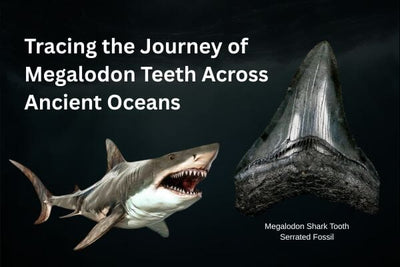Not many fossils make people feel wonder like the teeth from the Megalodon. These teeth are very big and sharp. They are from one of the largest sharks that ever lived on Earth. But it’s not just size that matters. Every tooth has a story of its own. These teeth tell us about seas that were different, animals that were here, and places that do not exist now. When we look at how these teeth went from inside a shark to being fossils, we can see the amazing path they took across old oceans.
The Megalodon: Giant of the Oceans
Megalodon, which is known to scientists as Otodus Megalodon, lived many years ago. It was here from about 23 to 3.6 million years ago. This was a very big shark. Some grew to the length of 60 feet. It was the top hunter in the oceans during its time in the Miocene and Pliocene periods. Megalodon had huge teeth. A lot of them were more than seven inches long. The teeth's shape helped it catch and eat big animals such as whales and large fish.
Looking at these teeth can help us know more about how the shark ate, how it grew, and where it went. The saw-like edges, the thick part of the tooth, and the marks from use all show us things about the shark’s life. From this, we see that this shark was a top hunter. It lived in many ocean waters for a long time.
From Living Shark to Fossil
The story of how a Megalodon tooth turns from something in a living creature to a fossil is very interesting. The main part of it is how the tooth stays safe through the years.
-
Tooth Loss: Megalodon, just like sharks today, would drop its teeth many times in its life. Every tooth that falls out could become a fossil.
-
Burial by Sediment: When teeth hit the ocean floor, they get covered fast by sand and mud. This keeps them safe from things that could break them down.
-
Mineralization: For many years, minerals move in and replace the soft parts of the teeth. This is how teeth become hard fossils.
-
Geological Movement: The Earth moves and changes, oceans shift, and continents slide. All this makes fossils move far from where they started.
Teeth can travel a long way in this process. In the end, you may find them in layers. These layers show us what ocean life was like many years ago.
Ancient Oceans and Fossil Distribution
Megalodon teeth are found in many parts of the world. This shows that the shark lived in lots of places.
-
North and South America: There are a lot of Megalodon fossils in Florida, North Carolina, and Peru. This means the warm water by the shore was a good home for these big sea animals.
-
Europe and Africa: People found fossils near the Mediterranean and by the West African coast. This shows that the area was a large place for hunting.
-
Asia and Oceania: People found fossils in Pakistan and Australia. This tells us that the shark
-
swam in oceans that were connected.
These fossils help scientists get a better idea of old ocean currents. They also show how predators and prey live with each other. The fossils can tell us what ocean life was like at that time.
What Teeth Reveal About Prehistoric Life
Megalodon teeth are very big and strong. These teeth help us know more about these old animals and the places they lived.
-
Predation Patterns: Wear marks on the teeth show what kind of animals the Megalodon would hunt and eat.
-
Ocean Chemistry: A close look at tooth enamel gives us clues about water, heat, and salt levels in the past.
-
Migration Evidence: The places where we find Megalodon teeth show the shark moved a lot and went to many continents.
-
Ecological Context: The teeth help experts see what animals lived in the sea, what food they had, and which ones were bosses in the food chain.
Researchers look at fossil clues and build on geological facts. By doing this, they get a better idea of how life used to be in the ancient oceans.
Preserving Fossil Megalodon Teeth
Collectors and people who like these items can keep the science part and the beauty of their specimens safe. They just need to follow a few simple rules:
-
Keep teeth in a steady spot that is dry. This helps stop them from getting cracks.
-
Do not use strong cleaners. These can hurt the enamel or change how the fossil looks.
-
Put on gloves when you hold them. This helps keep the natural shine of the minerals.
Good care keeps these old items looking good. It helps them stay useful in science for a long time.
Connecting With History Through Fossil Age Minerals
At Fossil Age Minerals, you will find a Megalodon tooth that comes with papers to prove it is real. This helps people feel a link to the old oceans, but in a safe way. There are also ammonites, sea fossils, and other old items here. These teeth let people feel close to the big animals that used to rule the sea.
Looking at Megalodon fossils is more than finding and keeping them. It helps us learn how old sea life worked and see how amazing these ancient creatures really were.
Fossil Age Minerals lets people follow the path of these giant hunters as they moved across the world. It helps us know and feel more about our planet’s past. You can read and find out more at Fossil Age Minerals.


